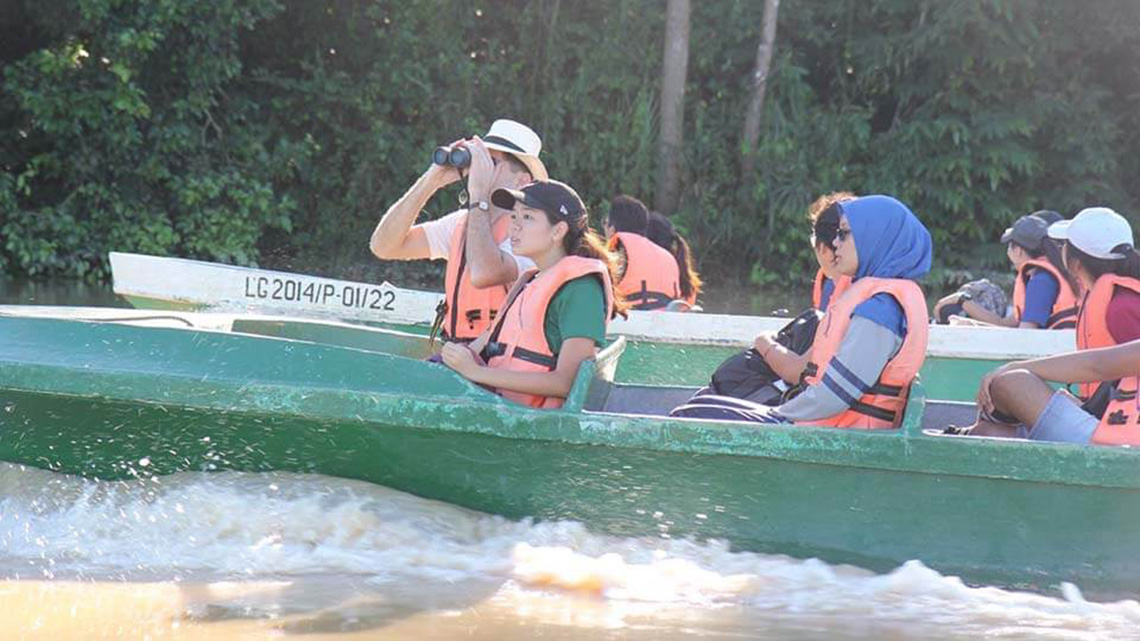By Professor Tommy Koh: Is Singapore A Small Country?
As Singapore’s fifty second national day draws near, my thoughts have turned increasingly towards our beloved country, Singapore. I have also been reflecting on the recent debate between two good friends, Kishore Mahbubani and Bilahari Kausikan, on the diplomacy of small states.
The question which I would like to answer in this essay is whether Singapore is a small country. The answer may seem obvious but it is not. It depends on the yardstick we use to measure Singapore’s size. If we use the yardstick of size of territory or the size of population, then Singapore is certainly a small country.
Prosperity Yardstick
Let us use a different yardstick, the GDP per capita based on Purchasing Power Parity (PPP). Qatar, Luxembourg, Macao, Singapore and Brunei are the top five, ranked in that order. USA is ranked number 13 and China number 81. By this yardstick, Singapore is the fourth richest country in the world.
Human Development Index
Many people have criticized the use of GDP per capita to assess a country’s prosperity. The argument is that it is uni-dimensional and does not necessarily reflect the state of well-being of the people. In response to such criticisms, the UN has created the Human Development Index.
In the 2016 Human Development Index, Singapore is ranked number 6, after Norway, Australia, Switzerland, Germany and Denmark. Singapore is the only Asian country in the top 10.
Power of Trade
With a population of only 5 million, Singapore has a small domestic market. It has no choice but to be outward oriented and to uphold and practise free trade. With such a small domestic market, we would not expect Singapore to rank very high in the WTO’s lists of the world’s leading exporters and importers. Our readers would be surprised to learn that Singapore is the world’s 13th largest exporter and the world’s 15th largest importer. In other words, Singapore is one of the world’s largest trading entities. This gives us relevance and influence at the WTO. This factor combined with the brilliance of our diplomats account for the fact that Singapore is regularly invited by the leaders of WTO to participate in the so-called Green Room negotiations.
Power of Money
It is a fact that in this money-loving world, money is power. Let us look at the yardstick of the size of a country’s foreign exchange reserves. Singapore has the world’s 11th largest foreign exchange reserves. China and Japan are ranked 1 and 2 in that order.
Let us now turn to another yardstick, the size of a country’s foreign direct investment. It is not surprising that USA, UK, Germany, France and Switzerland are the top 5 investors. I was not surprised that Singapore occupies the 10th position. I am not surprised because, despite our small size, Singapore is the largest foreign investor in China, India and Indonesia.
Another yardstick is the status of Singapore as a financial centre. According to the Global Financial Centres Index (2017), Singapore is ranked number 3, after London and New York and ahead of Hong Kong and Tokyo. According to the International Financial Centres Development Index, Singapore is ranked number 4, after New York, London and Tokyo and ahead of Hong Kong and Shanghai.
Power of Communications
The world is driven by international trade and international business. Shipping and aviation play an essential role in facilitating trade. Ships and aircraft need seaports and airports. There is a global network of the leading seaports and airports.
How does Singapore rank among the world’s busiest seaports? Singapore is ranked number 2 in the list of the world’s busiest seaports by cargo tonnage. Shanghai is ranked number 1. Singapore is also ranked number 2 in the list of the world busiest container ports. Shanghai is again ranked number 1.
What about Singapore’s Changi Airport. By the yardstick of the number of passengers using the airports, the Changi Airport is ranked number 17 in the world. The top 3 airports are Atlanta, Beijing and Dubai. However, Skytrax has frequently ranked Changi as the best airport in the world. Changi is therefore not the busiest but the best.
Power of Good Governance
A country’s good governance is also a source of power and influence in the world. Singapore’s relative absence of corruption, its strong rule of law and the good balance between development and environment are much admired by the world. The fact that the World Bank has ranked Singapore second in the list of countries for ease of doing business is an asset. The fact that Singapore is a very liveable city and is clean and green is also an asset. Foreigners also praise Singapore’s safety and envy the fact that in Singapore women can go out on their own at any time of the day and night.
Diplomatic Power
Singapore’s diplomats and the Ministry of Foreign Affairs (MFA) have generated diplomatic influence for Singapore. For example, MFA administers a multi-million dollar programme to assist other developing countries called the Singapore Cooperation Programme (SCP). Singapore does not give money to other countries because of the risk that it will be diverted. However, Singapore has been extremely generous in sharing our experience, knowledge or expertise. To-date, Singapore has trained over 100,000 officials from over 75 countries.
At the UN, Singapore had taken the initiative to establish the Forum of Small States consisting of 107 small countries. Singapore had also taken the initiative to establish the Global Governance Group, consisting of 30 small and medium economies. Our leadership of the two groups has contributed to our diplomatic power.
Brain Power
The world is going through a technological revolution which some have called the Fourth Industrial Revolution. In the new economy, the most important resource of a country is not its natural resources but its people or brain power. Singapore is doing a commendable job in educating and training its people. Singapore’s primary and secondary school students have been ranked number 1 in the world for maths and science. The National University of Singapore has been ranked as the best university in Asia.
Soft Power
A British Company, Portland, has published the world’s first index ranking countries for their soft power. In the 2017 index, Singapore is ranked number 20. Of the Asian countries only 4 make it to the list of the top 30. Japan is ranked number 6, South Korea is ranked number 21 and China is ranked number 25.
Another reflection of the soft power of countries is to be found in the Economist Intelligence Unit’s where to be born index. Switzerland is much admired by the world and occupies the top spot. I was pleasantly surprised to see Singapore in the sixth spot.
Conclusion
My answer to the question whether Singapore is a small country is that it depends on the chosen yardstick. In some respects, Singapore is a small country. In other respects, Singapore has out-performed other bigger countries. Singaporeans should be quietly proud of our achievements but they should remain humble and modest. We must never become proud and arrogant. In our relations with other countries, including the major powers, we should be respectful but not submissive. We should never hesitate to defend our national interests.
By Professor Tommy Koh: ASEAN and the European Union
This is a big year for ASEAN and the EU. ASEAN is celebrating its 50th anniversary. The EU is celebrating its 60th anniversary. The EU, notwithstanding the decision by the UK to leave the union, is often referred to as the most successful regional organization in the world. ASEAN is often referred to as the second most successful regional organization.
In this essay, I would like to compare and contrast the similarities and differences between ASEAN and the EU. I will begin with the similarities.
Similarities
The first similarity is that both are regional organizations with legal personalities. The EU has 28 members and will have 27 in March 2019. ASEAN has 10 members with Timor Leste knocking on the door.
The second similarity is that both were founded to promote peace. The EU was founded, after two disastrous world wars, to prevent the recurrence of war in Europe and to institutionalize peace through economic integration. ASEAN was founded to create a peaceful environment in Southeast Asia so that the ASEAN countries could focus their energies on their economic development.
The third similarity is that both seek to integrate the economies of their member states into a single market and production platform. In the case of the EU, there is freedom of movement of goods, services, capital and labour. In the case of ASEAN, the movement labour is not free. The ASEAN Charter only obliges the member states to facilitate the movement of business persons, professionals, talents and labour. This is a major difference between ASEAN and the EU.
The fourth similarity is that both organizations share a commitment to human rights. The EU has a Charter of Fundamental Rights and ASEAN has a Declaration of Human Rights. The ASEAN Charter contains several provisions in its Preamble, Purposes and Principles, on human rights. ASEAN has two commissions on human rights: (1) the ASEAN Intergovernmental Commission on Human Rights; and (2) the Commission on the Rights of Women and Children. However, the EU has a Court of Human Rights, in addition to the Court of Justice and Court of Auditors. ASEAN does not have a court.
The fifth similarity is that both ASEAN and the EU have concluded many free trade agreements or comprehensive economic partnership agreements with other countries. For example, the EU and Singapore have concluded a free trade agreement which is pending ratification. ASEAN has concluded such agreements with China, Japan, South Korea, India, Australia and New Zealand but not with the EU.
The sixth similarity is that both ASEAN and the EU hold regular political and economic dialogues with important external partners. The EU holds annual summits with the US, China, Japan, Russia, etc. ASEAN has created three forums to engage its external partners, namely, the ASEAN Regional Forum, ASEAN Plus Three and the East Asia Summit. In addition, ASEAN holds bilateral dialogues with its 10 Dialogue Partners. Finally, ASEAN holds an annual summit with the US, China, India, Japan and South Korea.
Differences
There are several important differences between ASEAN and the EU. The first difference is that ASEAN is an intergovernmental organization. The EU, in contrast, is a supranational organization in which its member states have agreed, in certain areas, such as trade, to pool their sovereignties. In other words, the member states have voluntarily agreed to give up part of their sovereignty. The pooled sovereignty is exercised by the European Commission on behalf of the member states.
The second difference is that the EU has a common currency called the euro. Only 19 of the EU’s 28 members are members of the Eurozone. ASEAN does not have a common currency and has no plans to do so. However, in the aftermath of the 1997 Asian Financial Crisis, ASEAN together with China, Japan and South Korea launched the so-called Chiang Mai Initiative. The project brings together the 13 Finance Ministers and Central Bank Governors. Their agenda is to promote greater financial cooperation among the 13 countries.
The third difference is that the EU has a Parliament and ASEAN does not. The European Parliament has the power to legislate as well as the power to veto budgets and appointments. ASEAN has the ASEAN Inter-Parliamentary Assembly which has only the power of moral suasion.
The fourth difference is that the EU has a very powerful Secretariat called the European Commission and ASEAN has a relatively small and weak Secretariat. The European Commission acts like a government and is entitled to enter into treaties. The Commission has the power to put forward proposals for legislation. The ASEAN Charter has enhanced the power of the Secretary-General. One of his most important responsibilities is to issue an annual report card on each member state’s compliance with its obligations.
The fifth difference is in the decision-making process. ASEAN takes all its decisions by consensus. The EU can decide by taking votes. There is a system of weighted voting, with different countries being given different numbers of votes. However, in the area of common foreign and security policy, decisions are based on unanimity. In ASEAN’s case, there is an exception to the consensus rule: economic agreements can be adopted by a majority, using the “ASEAN minus X” formula. The logic is that the majority can proceed first and the minority will catch up later.
The sixth difference is on language policy. The EU has 23 official languages. In the cast of ASEAN, English is used as the sole medium for meetings and communications.
Conclusion
I want to conclude by expressing my confidence in the EU. I believe that the EU, without the UK, will be stronger and not weaker because it will be more cohesive. I do not believe that the EU will break up or that the euro will fail. In the same way, I believe that ASEAN will overcome its challenges and remain united and independent. Learning from the experience of the EU, ASEAN will redouble its efforts to ensure that it is not viewed as an elitist project. Instead, ASEAN must ensure that it enjoys the support of the 625 million citizens of ASEAN.
Into the heart of Borneo
The group spotted a myriad of species on a cruise down the Kinabatangan River in Sabah
A group of 14 NUS students, led by historian of science Dr John van Wyhe from Tembusu College and NUS Biological Sciences, undertook an extraordinary expedition through Borneo from 8 to 20 May under the Study Trips for Engagement and EnRichment (STEER) programme to study the state of nature conservation on the world’s third-largest island.
The first stop was Kuching, the capital of Sarawak, Malaysia, where the team toured the historic city centre, including the Brooke Gallery housed in the 1880 Fort Margherita. They also visited Matang Wildlife Centre, home to hundreds of rescued animals including orangutans, sun bears, gibbons, hornbills, crocodiles and leopard cats, and learnt about the difficulties in rehabilitating wild animals that have spent too much time with humans, as pets for example.
The group then travelled by sea to Bako National Park under the expert guidance of a representative of the Malaysian Nature Society (Kuching Branch). Along the beaches and in the forests of Bako, they had close encounters with Langur monkeys, the bright-eyed Bornean bearded pig, fat-bellied Proboscis monkeys, a large tree snake, flying geckos and the strange Colugo or flying lemur, as well as many unique species of pitcher plants.
An unexpected flight cancellation left them stranded overnight in Kuching. However, the students managed to salvage the expedition by splitting into groups to book accommodation and a next-day flight to Mulu on a small twin-engine aircraft. As they flew over Sarawak, they saw vast geometric blocks of oil palm plantations rapidly replacing Borneo’s native forest, which gave way to a multicoloured carpet of virgin forest as they briefly crossed the Bruneian border.
At Gunung Mulu National Park in Sarawak, the group visited the village of Batu Bungan, accompanied by a local Penan guide. The Penan were, until recently, hunter gatherers in the forests of Borneo and, remarkably, there are still about 300 Penan living as nomads in the area. It was here also that Dr van Wyhe was particularly excited to spot one of the most beautiful insects in the world, the Rajah Brooke butterfly, first discovered in Sarawak by famed naturalist Alfred Russel Wallace in 1855.

The beautiful Rajah Brooke butterfly in Sarawak
Next up were the famous limestone caves, nesting place of millions of birds and bats. That evening, the group caught a breathtaking display of the nightly exodus of millions of bats spiralling up into the sky.
The expedition travelled next to Brunei where they were hosted by staff and students of the Universiti Brunei Darussalam. After a long boat voyage to the Kuala Belalong field studies centre deep in the jungle, they saw more unique wildlife and had the opportunity to meet modern-day Wallaces — researchers discovering and collecting new species. They also met Mr Lim Hong Huai and Mr Raymond Chew, Singapore’s High Commissioner and Deputy High Commissioner to Negara Brunei Darussalam respectively.
The group then flew to Kota Kinabalu in Sabah where they toured the Sabah Museum, a natural history and cultural museum, before heading to Sandakan and meeting members of the eco-tourism and conservation group APE Malaysia. Under their guidance, the group visited the Sepilok Orangutan Rehabilitation Centre within the Kabili-Sepilok Forest Reserve, where they got up close and personal with orangutans, sun bears and brightly-coloured short-tailed macaques.
At the tiny village of Sukau along the Kinabatangan River, they spotted a myriad of beautiful species such as the Serpent eagle, Black eagle, Purple heron, Stork-billed kingfisher, and the giant Storm stork, of which less than 500 survive in the wild. The group also helped to plant 100 native tree saplings in a part of the forest destroyed by logging, and were treated to dinner in a house on stilts by a local family.
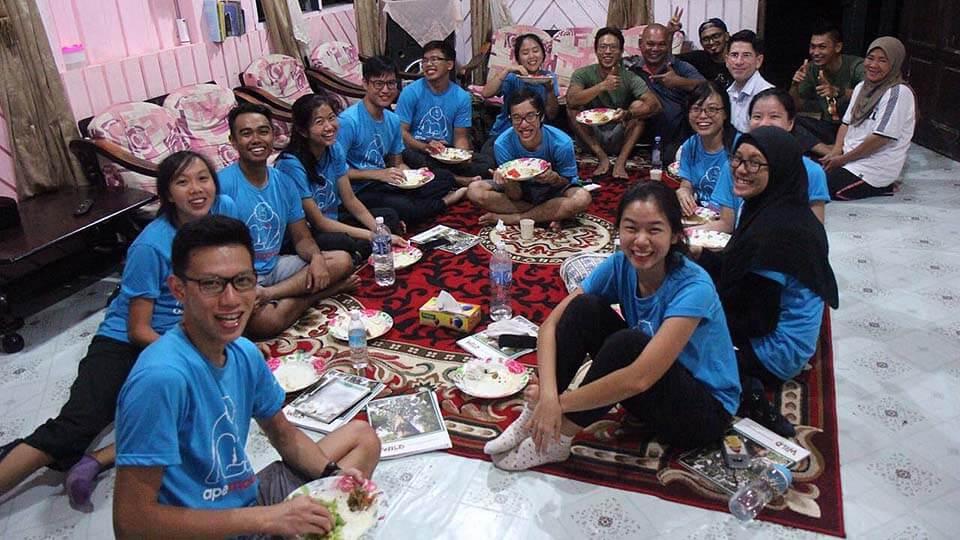
Having a meal with a local family in Sukau
A highlight of the trip happened on the final river cruise, where the students witnessed, from only a few meters away, a group of Pygmy elephants feeding by the water’s edge, and heard the distinctive trumpeting emanating from the nearby forest. They also observed, enthralled, a wild female orangutan and her child high up in the branches.
Save for a few bumps, bites and bruises, the team returned safely to Singapore with experiences of the region to last a lifetime.
Island adventurer: Alfred Russel Wallace and the quest for the origin of species
Catch the video of Dr John van Wyhe on BBC Travel here
In honour of the centenary of the great Victorian naturalist, Alfred Russel Wallace, John van Wyhe wrote and curated the Wallace exhibition at Science Centre Singapore, co-sponsored by the Faculty of Science, NUS. This animated biography of Wallace was made for the exhibition.
The opening title sound recording of the song of Wallace’s standard wing bird of paradise was recorded on Halmahera by John van Wyhe.
Denise Goh Hui Jun on hospitality and the Rohingya Refugee in Berfrois
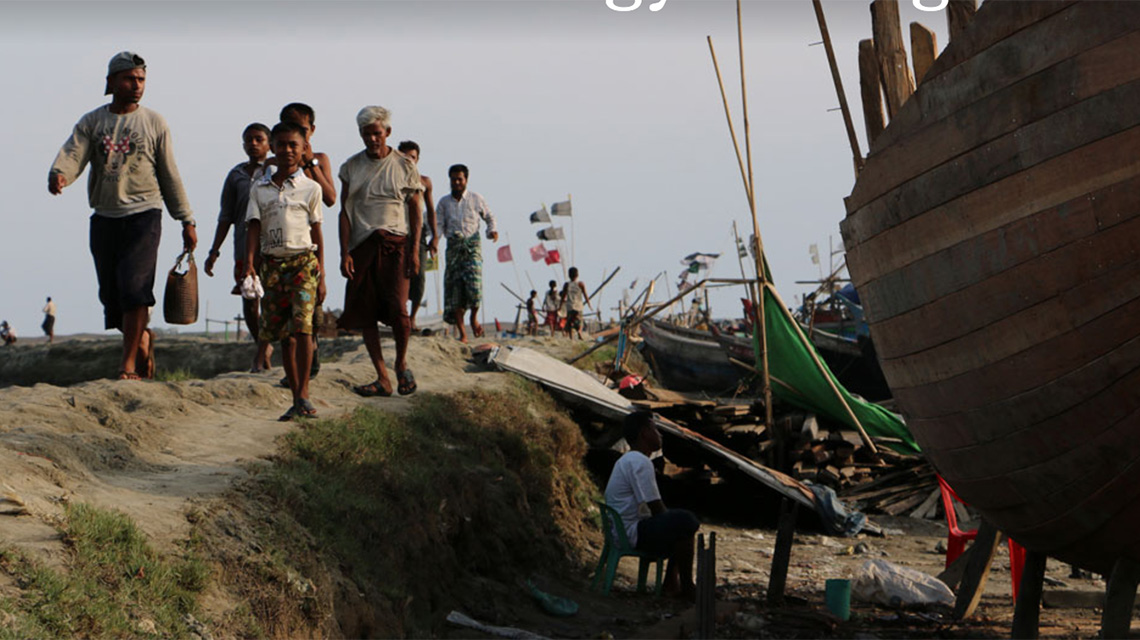
Many congratulations to Denise Goh Hui Jun on the publication of her essay, ‘Welcoming Possibility: Hospitality and the Rohingya Refugee’ — which was first conceived as part of her Independent Study Module with Dr Adam Groves — in Berfrois: Intellectual Jousting in the Republic of Letters
Her essay can be read here : http://www.berfrois.com/2017/05/denise-goh-hui-jun-hospitality-rohingya-refugee/
Crosshouse from Tembusu featured in NUS admissions campaign
Check out the video here.
Crosshouse, a band which originated from Tembusu College, has been featured in the latest NUS admissions campaign!
#NUSBeyond #mychoiceNUS
the didactic will be the discussion: a conversation of poems …
The Arts House
730pm
21.04.2017
Poets — Readers — Speakers
Philippe Beck is a contemporary French poet, writer, and philosopher. He is Professor of Poetry at The European Graduate School, and of Philosophy at l’Université de Nantes. Interested in the nature of the poetic experience, for Beck, the poetic today lies not only between scientific experience and common sense experience but allows for their communicability — and his work traverses poetry, poétologie, prose, and philosophy. He has published sixteen books of poetry and was awarded the Grand Prix de Poésie from the French Academy in 2015 in recognition of his poetic œuvre.
Lim Lee Ching teaches literature and interdisciplinary subjects at SIM University, Singapore. He is the author of The Works of Tomas Tranströmer: The Universality of Poetry (Cambria, 2017), and has edited Peter van de Kamp’s 2010 collection of poetry, Scratch & Sniff. Ching’s poems have been published in One Imperative, as well as been collected alongside Geraldine Song’s works, To Thee Do We Cry, Poor Banished Children (2013), and Semoga Bahagia (2015). Ching is the founding editor of The Singapore Review of Books.
Adam Staley Groves is the author of two complete volumes of poetry, Filial Arcade and Poetry Vocare. An individually published poem “Etui” was recently adopted to a contemporary classical music composition through Gaudeamus, in The Netherlands.
Moderator
Jeremy Fernando is the Jean Baudrillard Fellow at the European Graduate School, where he is also a Reader in Contemporary Literature & Thought. He has written eighteen books; and has been translated into French, Japanese, Italian, Spanish, and Serbian. He is the general editor of the thematic magazine One Imperative; and is a Fellow of Tembusu College at the National University of Singapore.
***
This event is brought to you by Voilah ! 2017 French Festival and Delere Press, in conjunction with The European Graduate School, and is supported by The Arts House
***
With thanks, and much appreciation, to Mark Chua & Lam Li Shuen of Emoumie Productions for so very kindly helping us to film and record the conversation.
Bringing Interdisciplinary Learning to and Beyond Tembusu College
In collaboration with FASS Science, Technology, and Society Cluster, Dr Margaret Tan convened the symposium Zero Day: Science, Technology, Society and the Imagination. The symposium wanted to fill a gap in STS studies by bringing art into the equation. It brought in theorists and practitioners straddling the fields of art, science, and technology and sought to uncover the relationships between new media artistic practices and research, as well as what we can learn from new media art practitioners. The symposium was successful in attracting quite a diverse group of graduate students and researchers from different faculties and institutions beyond Tembusu College and NUS. It is testament to the keen interest out there in interdisciplinary enquiry. In addition, three artists speaking at the symposium, and housed at Tembusu College, conducted RasberryPi and 360 degree VR workshops for our students.
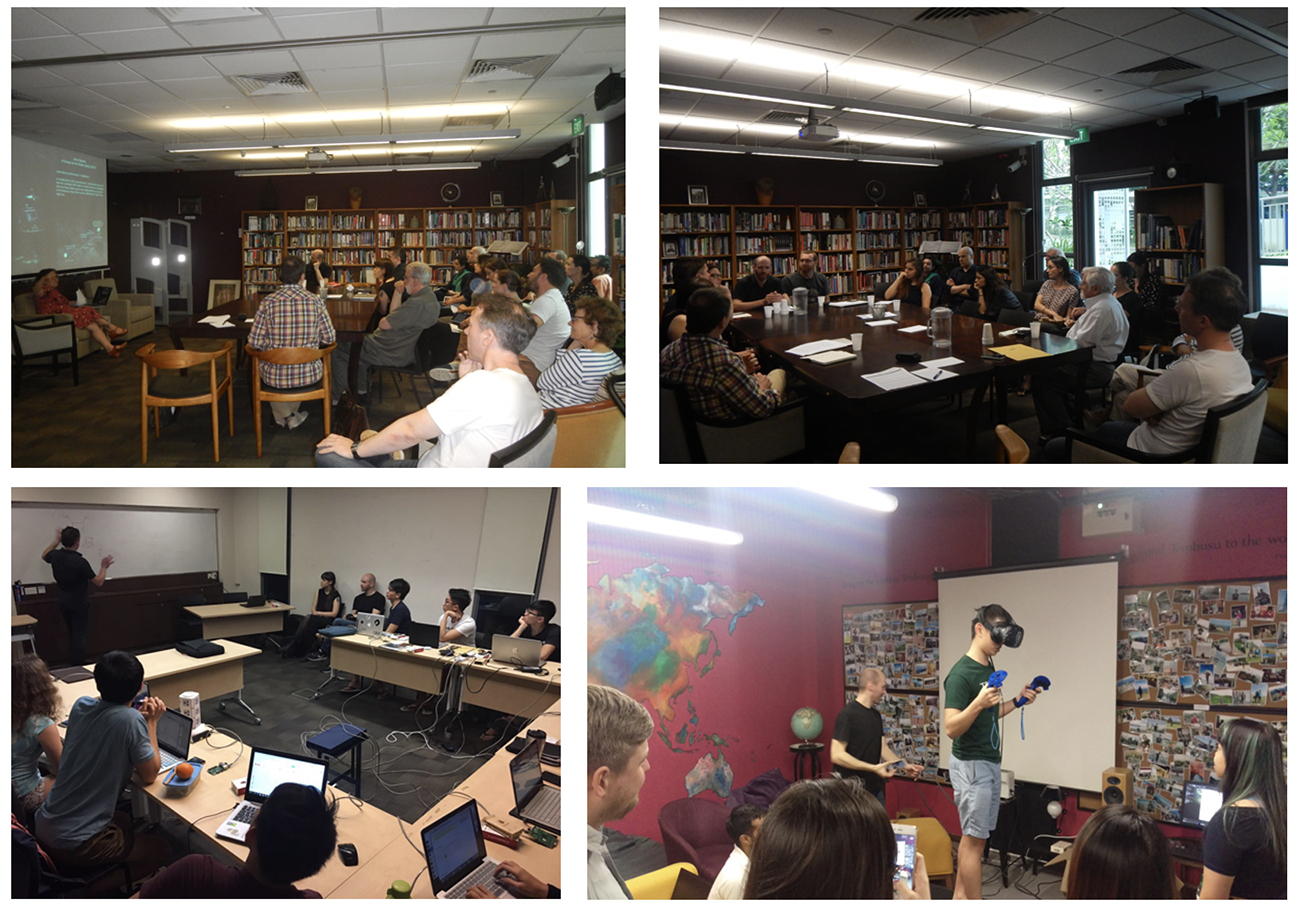
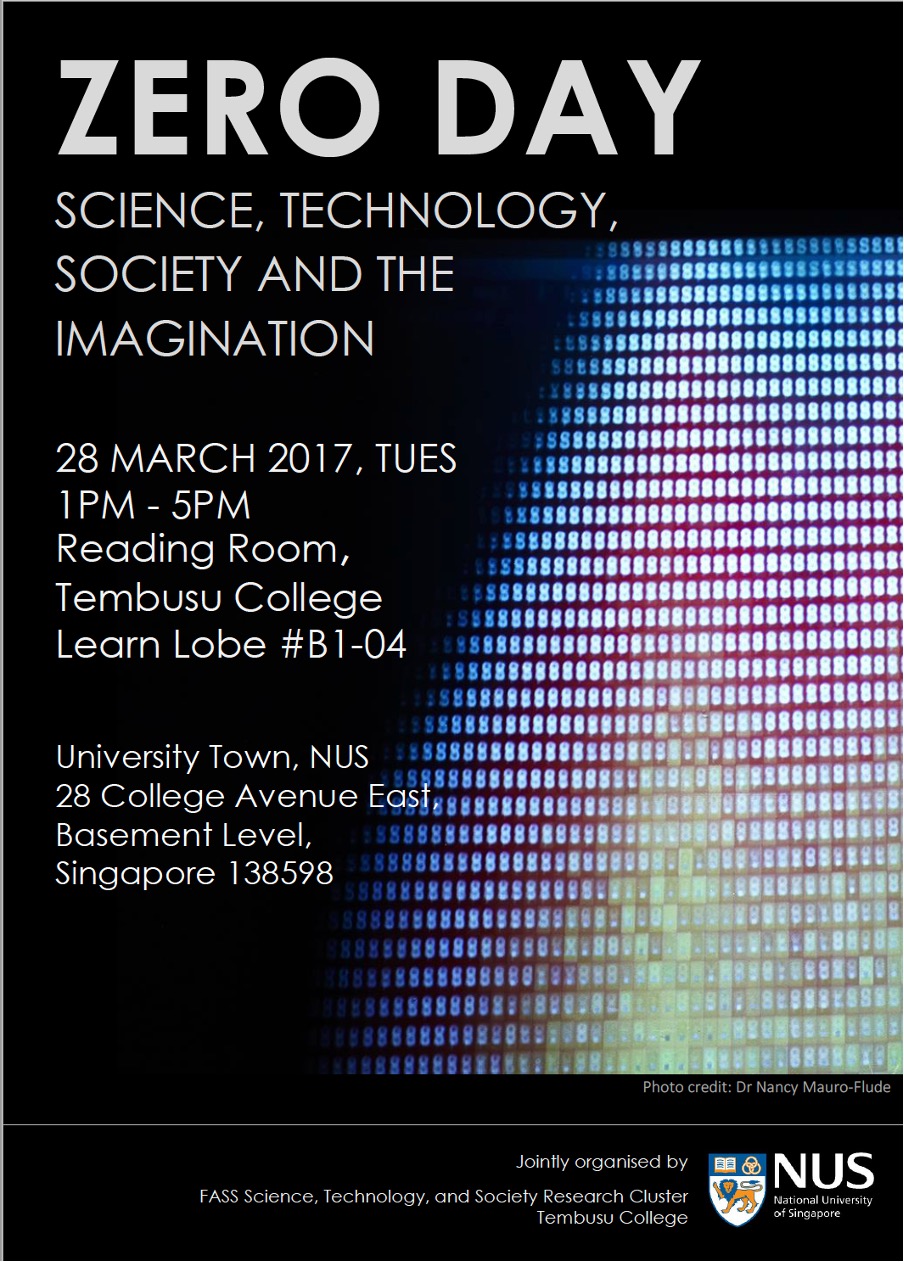


Jeremy Fernando at the NUS Arts Festival 2017
On 22 March 2017, as part of the Centre for the Art’s NUS Arts Festival 2017, Jeremy Fernando performed a talk, ‘On Interventions — or, space is only noise if you can see, which attempted to meditate on the notion of interventions, on the relationship between the one who intervenes and the site, peoples, spaces, sounds, of the intervention.
The performance, which was held at the NUS Museum, was moderated by Yanyun Chen from Yale-NUS College; and is dedicated to all the students who have taken the ‘Singapore as “Model” City?’ senior seminar over the years: without their intelligence, creativity, and warmth — alongside their wonderful intervention projects — none of this would have been possible.


